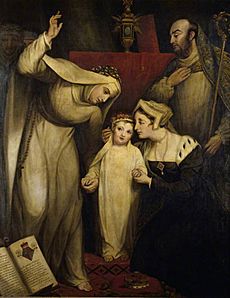Elizabeth Cressener facts for kids
Quick facts for kids
Elizabeth Cressener
|
|
|---|---|
| Born | c. 1457 |
| Died | 1536/7 |
| Nationality | Kingdom of England |
| Occupation | Dominican nun |
| Known for | Prior of Dartford Priory |
| Predecessor | Alice |
| Successor | Joan Vane |
Elizabeth Cressener (born around 1457, died 1536 or 1537) was an important English nun. She was the leader, called a Prioress, of a special group of Dominican nuns at Dartford Priory in Kent. One of her nuns was even a real princess, the daughter of King Edward IV. Elizabeth lived during a big change in England when many monasteries, including hers, were closed down by the King.
Contents
Early Life and the Priory
Elizabeth Cressener was born in East Anglia in the late 1450s. Her family was quite important and had connections to King Edward IV. They seemed to like the Dominican Order, as shown by graves of her relatives at Sudbury, where there was a Dominican Friary.
Dartford Priory was a special place for nuns, first started in 1356. The King at the time paid for four nuns from France to come and begin the priory. Kings and Queens often supported the priory with money and gifts. This support continued until many monasteries were closed down later.

Becoming Prioress
Elizabeth Cressener became the Prioress of Dartford Priory in 1489. She took over from a nun named Alice. As Prioress, Elizabeth was in charge of all the priory's lands and buildings. The priory owned many different properties.
In Kent, they had woods, houses, inns, mills, and even chalk quarries. They also owned land and had control over churches in many other parts of England. These included areas like Bedfordshire, London, Norfolk, and Wiltshire.
A Royal Nun
In Elizabeth's second year as Prioress, something very special happened. Bridget of York, the youngest daughter of King Edward IV, joined Dartford Priory. She was only ten years old at the time. As she grew up, Princess Bridget became one of Elizabeth Cressener's nuns.
Princess Bridget died by December 1507. Her brother-in-law, King Henry VII, paid for a stone to mark her grave.
Life at the Priory
Priories were home to nuns, who had taken special vows, and novices, who were training to become nuns. There were also people who helped with their spiritual needs. Sometimes, women who were not nuns were allowed to stay at priories. However, this was usually not allowed after 1503.
But in 1520, Elizabeth Cressener received a special permission. She was allowed to let any women stay at the priory, whether they were nuns or not. These women had to be from important families. They could wear nun's habits or their own clothes. Widows were also welcome, as well as young ladies who would be trained at the priory.
The Dissolution of the Monasteries
In 1536, a big change began in England called the Dissolution of the Monasteries. This was when King Henry VIII started closing down many religious houses. At first, monasteries with a small income (under £200 a year) were closed. The King's officials claimed some monasteries were not following religious rules.
Over 300 monasteries were closed in this first wave. However, about 80 smaller ones were allowed to stay open for a while. When a convent was closed, the Prioress might get a pension, but the other nuns would become homeless. They were allowed to move to other convents that were still open.
Elizabeth Cressener was worried that many nuns from closed convents might come to Dartford. She wrote to Thomas Cromwell, an important advisor to the King, to share her concerns. She explained that Dartford was the only Dominican nunnery in England. This meant that any new nuns would not be used to their specific way of life and rules.
Death and Legacy
Elizabeth Cressener died in Dartford around 1536 or 1537. Dartford Priory itself was closed down in 1539 as part of the ongoing Dissolution of the Monasteries.
In 1822, an artist named James Northcote painted a picture imagining the moment Princess Bridget of York joined the priory. Today, Elizabeth Cressener's name is remembered in Dartford. There is a street called Cressener Place, named after her and other Prioresses of the priory.

